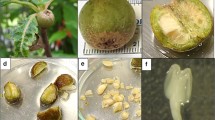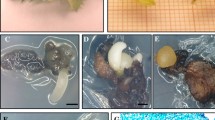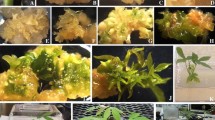Abstract
Theoretically, complete rejuvenation of mature trees should occur through somatic embryogenesis, however, this has not been extensively studied. The main objective of the present study was to increase the efficiency of in vitro clonal propagation for mature Quercus robur (100–300 years old), by induction of somatic embryogenesis as rejuvenation step prior to establishment of shoot culture through micropropagation of somatic embryo-derived plantlets. Shoot culture lines of “mature” origin were established from epicormic shoots of two centenarian oak genotypes (Sainza and CR-0) and maintained by axillary shoot proliferation. Embryogenic lines were also initiated from epicormic leaf explants of the same genotypes and maintained by secondary somatic embryogenesis. Although the frequency of somatic embryo conversion into plantlets was low in pedunculate oak, shoot culture lines could be established and maintained by axillary branching from several germinated somatic embryos. For each genotype and shoot culture line of the two origins (mature tree and somatic plantlets), shoot multiplication rate and elongation as well as rooting ability parameters were compared. Compared with “mature-origin” shoot cultures and after more than one year propagation in vitro, shoot lines established from somatic plantlets produced a significantly higher proportion of elongated, rootable shoots (from 26.0–31.6 to 36.8–40.5%) with increased rooting ability (from 3.3–45.6% to 23.2–89.8%). In the case of 300-year-old Sainza genotype such a high organogenic capacity was similar to shoot cultures initiated from basal sprouts. Basal sprouts are considered as “mature” material that retains juvenile characteristics compared with epicormic shoots forced from crown branches. Somatic embryogenesis only slightly improved plant regeneration of shoot cultures from basal sprouts, thus validating their use as “juvenile control”. The present results provide evidence that some rejuvenation occurred during the process of somatic embryogenesis and resulted in improved shoot growth and rooting of somatic embryo-derived culture compared with “mature” shoot culture. The results reported in this study might be useful in embryogenic systems with low plant conversion rates. The proposed experimental model might also be useful in finding molecular markers of plant ontogeny.


Similar content being viewed by others
References
Ballester A, Vidal N, Vieitez AM (2009) Developmental stages during in vitro rooting of hardwood trees from material with juvenile and mature characteristics. In: Niemi K, Scagel C (eds) Adventitious root formation of forest trees and horticultural plants—from genes to applications. Research Signpost, Kerala, pp 277–296
Baurens F-C, Nicolleau J, Legavre T, Verdeil J-L, Monteuuis O (2004) Genomic DNA methylation of juvenile and mature Acacia mangium micropropagated in vitro with reference to leaf morphology as a phase change marker. Tree Physiol 24:401–407
Bonga JM, Klimaszewska KK, von Aderkas P (2010) Recalcitrance in clonal propagation, in particular of conifers. Plant Cell Tissue Organ Cult 100:241–254
Breton D, Harvengt L, Trontin JF, Bouvet A, Favre JM (2006) Long-term subculture randomly affects morphology and subsequent maturation of early somatic embryos in maritime pine. Plant Cell Tissue Organ Cult 87:95–108
Carron MP, Etienne H, Lardet L, Campagna S, Perrin Y, Leconte A, Chaine C (1995) Somatic embryogenesis in rubber (Hevea brasiliensis Müll. Arg.). In: Jain S, Gupta P, Newton R (eds) Somatic embryogenesis in woody plants, vol 2. Kluwer, Dordrecht, pp 117–136
Celestino C, Hernández I, López-Vela D, Carneros E, Alegre J, Fernández-Guijarro B, Cardo L, Toribio M (2007) First data from a field trial of Quercus suber plants regenerated from mature selected trees and from their half-sib progenies by somatic embryogenesis. Acta Hortic 748:215–218
Chalupa V (2000) In vitro propagation of mature trees of pedunculate oak (Quercus robur L.). J For Sci 46:537–542
Covelo G, Ferro E, Vielba JM, Sánchez C (2009) Molecular analysis of adventitious rooting in Fagaceae species. In: Niemi K, Scagel C (eds) Adventitious root formation of forest trees and horticultural plants—from genes to applications. Research Signpost, Kerala, pp 105–122
Gil B, Pastoriza E, Ballester A, Sánchez C (2003) Isolation and characterization of a cDNA from Quercus robur differentially expressed in juvenile-like and mature shoots. Tree Physiol 23:633–640
Greenwood MS (1987) Rejuvenation of forest trees. Plant Growth Regul 6:1–12
Greenwood MS, Cui X, Xu F (2001) Response to auxin changes during maturation-related loss of adventitious rooting competence in loblolly pine (Pinus taeda) stem cuttings. Physiol Plant 111:373–380
Gresshoff PM, Doy CH (1972) Development and differentiation of haploid Lycopersicon esculentum. Planta 107:161–170
Hernández I, Cuenca B, Carneros E, Alonso-Blazquez N, Ruiz M, Celestino C, Ocaña L, Alegre J, Toribio M (2011) Application of plant regeneration of selected cork oak trees by somatic embryogenesis to implement multivarietal forestry for cork production. Tree For Sci Biotech 5 (special issue 1):19–26
Klimaszewska K, Trontin JF, Becwar MR, Devillard C, Park YS, Lelu-Walter MA (2007) Recent progress in somatic embryogenesis in four Pinus spp. Tree For Sci Biotech 1:11–25
Klimaszewska K, Noceda C, Pelletier G, Label P, Rodríguez R, Lelu-Walter MA (2009) Biological characterization of young and aged embryogenic cultures of Pinus pinaster. In Vitro Cell Dev Biol Plant 45:20–33
Klimaszewska K, Overton C, Stewart D, Rutledge RG (2011) Initiation of somatic embryos and regeneration of plants from primordial shoots of 10-year-old somatic white spruce and expression profiles of 11 genes followed during the tissue culture process. Planta 233:635–647
Mankessi F, Saya A, Baptiste C, Nourissier S, Monteuuis O (2009) In vitro rooting of genetically related Eucalyptus urophylla × Eucalyptus grandis clones in relation to the time spent in culture. Trees 23:931–940
Martínez T, Corredoira E, Valladares S, Jorquera L, Vieitez AM (2008) Germination and conversion of somatic embryos derived from mature Quercus robur trees: the effects of cold storage and thidiazuron. Plant Cell Tissue Organ Cult 95:341–351
McGowran E, Douglas GC, Parkinson M (1998) Morphological and physiological markers of juvenility and maturity in shoot cultures of oak (Quercus robur and Q. petraea). Tree Physiol 18:251–257
Merkle SA, Nairn CJ (2005) Hardwood tree biotechnology. In Vitro Cell Dev Biol Plant 41:602–619
Monteuuis O, Bon MC (1989) Rejuvenation of a 100 yr old giant sequoia (Sequoiadendron giganteum Buchholz) through in vitro meristem culture. Ann Sci For 46(suppl):183s–186s
Monteuuis O, Doulbeau S, Verdeil JL (2008) DNA methylation in different origin clonal offspring from mature Sequoiadendron giganteum genotype. Trees 22:779–784
Murashige T, Skoog F (1962) A revised medium for rapid growth and bio-assays with tobacco tissue cultures. Physiol Plant 15:473–497
Noceda C, Salaj T, Perez M, Viejo M, Canal MJ, Salaj J, Rodriguez R (2009) DNA demethylation and decrease on free polyamines is associated with the embryogenic capacity of Pinus nigra Arn. cell cultures. Trees 23:1285–1293
Perrin Y, Doumas P, Lardet L, Carron MP (1997) Endogenous cytokinins as biochemical markers of rubber-tree (Hevea brasiliensis) clone rejuvenation. Plant Cell Tissue Organ Cult 47:239–245
Pierik RLM (1990) Rejuvenation and micropropagation. In: Nijkamp HJJ, Van der Plas LHW, Van Aartrijk J (eds) Progress in plant cellular and molecular biology. Kluwer, Dordrecht, pp 91–101
San-José MC, Corredoira E, Martínez MT, Vidal N, Valladares S, Mallón R, Vieitez AM (2010) Shoot apex explants for induction of somatic embryogenesis in mature Quercus robur L. trees. Plant Cell Rep 29:661–671
Toribio M, Fernández C, Celestino C, Martínez MT, San-José MC, Vieitez AM (2004) Somatic embryogenesis in mature Quercus robur trees. Plant Cell Tissue Organ Cult 76:283–287
Traore A, Maximova SN, Guiltinan MJ (2003) Micropropagation of Theobroma cacao L. using somatic embryo-derived plants. In Vitro Cell Dev Biol Plant 39:332–337
Valladares S, Sánchez C, Martínez MT, Ballester A, Vieitez AM (2006) Plant regeneration through somatic embryogenesis from tissues of mature oak trees: true-to-type conformity of plantlets by RAPD analysis. Plant Cell Rep 25:879–886
Vidal N, Arellano G, San-José MC, Vieitez AM, Ballester A (2003) Developmental stages during the rooting of in vitro cultured Quercus robur shoots from material of juvenile and mature origin. Tree Physiol 23:1247–1254
Vieitez AM, Sánchez MC, Amo-Marco JB, Ballester A (1994) Forced flushing of branch segments as a method for obtaining reactive explants of mature Quercus robur trees for micropropagation. Plant Cell Tissue Organ Cult 37:287–295
Vieitez AM, Corredoira E, Ballester A, Muñoz F, Duran J, Ibarra M (2009) In vitro regeneration of the important North American oak species Quercus alba, Quercus bicolor and Quercus rubra. Plant Cell Tissue Organ Cult 98:135–145
Vieitez AM, Corredoira E, Martínez MT, San-José MC, Sánchez C, Valladares S, Vidal N, Ballester A (2011) Application of biotechnological tools to Quercus improvement. Eur J Forest Res. doi:10.1007/s10342-011-0526-0
Von Aderkas P, Bonga J (2000) Influencing micropropagation and somatic embryogenesis in mature trees by manipulation of phase change, stress and culture environment. Tree Physiol 20:921–928
Weng Y, Park YS, Krasowski MJ (2010) Managing genetic gain and diversity in clonal deployment of white spruce in New Brunswick, Canada. Tree Gen Genom 6:367–376
Acknowledgments
We thank M. J. Cernadas and C. García for technical assistance. This research was partially funded by Xunta de Galicia and Consejo Superior de Investigaciones Científicas (Spain) through the projects 09MRU002400PR and PIE200940I011, respectively.
Author information
Authors and Affiliations
Corresponding author
Additional information
Communicated by K. Klimaszewska.
Rights and permissions
About this article
Cite this article
Martínez, T., Vidal, N., Ballester, A. et al. Improved organogenic capacity of shoot cultures from mature pedunculate oak trees through somatic embryogenesis as rejuvenation technique. Trees 26, 321–330 (2012). https://doi.org/10.1007/s00468-011-0594-2
Received:
Revised:
Accepted:
Published:
Issue Date:
DOI: https://doi.org/10.1007/s00468-011-0594-2




